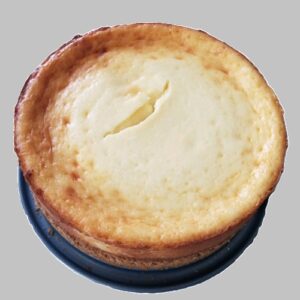|
Listen to article
Getting your Trinity Audio player ready...
|
So, picture this: you’ve spent hours in the kitchen, carefully crafting what you hoped would be the perfect cheesecake. But alas, when you pull it out of the oven, it’s a tad more done than you’d like. Now the burning question is how to fix overcooked cheesecake. Don’t worry! We’ve all been there. Thankfully, with a little kitchen magic and some expert tips, you can rescue that overcooked cheesecake and turn it into a dessert masterpiece.
In this guide, we’re going to dive into the secrets of fixing an overcooked cheesecake, so you can salvage your sweet creation and still impress your guests. Let’s get cooking and save that cheesecake!
You would also like to know What Does Sour Cream Do in Cheesecake?
Contents
- 1 What Are the Signs of Overcooked Cheesecake?
- 2 How to fix overcooked cheesecake
- 3 FAQs
- 3.1 What is the best method for fixing an overcooked cheesecake?
- 3.2 Should I use a water bath when reheating the cheesecake?
- 3.3 How can I prevent my cheesecake from overcooking in the first place?
- 3.4 Can I fix an overcooked cheesecake without reheating it?
- 3.5 How long will it take to fix an overcooked cheesecake?
- 4 Conclusion
What Are the Signs of Overcooked Cheesecake?
As a chef, identifying signs of an overcooked cheesecake is crucial for ensuring a perfect dessert every time. Here are the telltale indicators to watch for:
- Excessive Browning: A cheesecake that emerges from the oven with a significantly darker top than desired indicates overcooking.
- Cracks: Overcooking can cause unsightly cracks to form on the surface of the cheesecake as it dries out too much during baking.
- Dry Texture: Overcooked cheesecake lacks the creamy, velvety texture that defines a perfectly baked one, instead appearing dry and rubbery.
- Shrinking from the Sides: When a cheesecake pulls away excessively from the sides of the pan, it signals that it has been cooked for too long.
- Tough Edges: Overcooking can result in tough, chewy edges rather than the soft, delicate ones characteristic of a well-baked cheesecake.
- Lack of Jiggle: A properly baked cheesecake should exhibit a subtle jiggle in the center when gently shaken. If it’s entirely firm, it’s a clear sign of overcooking.
Mastering the art of recognizing these signs allows chefs to intervene promptly and salvage even an overcooked cheesecake, turning a potential mishap into a triumph of culinary expertise.

How to fix overcooked cheesecake
As a chef, fixing an overcooked cheesecake is all about finesse and precision. Here’s a comprehensive guide on how to fix an overcooked cheesecake:
Assessment and Analysis:
Begin by carefully examining the cheesecake. Note any signs of overcooking such as excessive browning, cracks, or a dry texture. Understanding the extent of the damage will inform your strategy for restoration.
Preparation for Reheating:
Preheat your oven to a low temperature, typically around 300°F (150°C). Meanwhile, prepare a water bath by filling a baking dish with hot water and placing it on the bottom rack of the oven. This will create a humid environment, crucial for adding moisture back into the cheesecake as it reheats.
Reheating Process:
Gently place the overcooked cheesecake in the center of the oven. Allow it to reheat slowly at the low temperature. Keep a close eye on it to prevent further drying out or burning.
Aluminum Foil Shield:
If the top of the cheesecake is excessively browned, loosely cover it with aluminum foil. This will help shield the surface from further browning while the interior reheats evenly.
Temperature Monitoring:
Utilize an instant-read thermometer to monitor the internal temperature of the cheesecake. Aim for a temperature of around 150°F (65°C). Once it reaches this temperature, remove it from the oven.
Gradual Cooling:
After removing the cheesecake from the oven, allow it to cool gradually. Leave the oven door slightly ajar and let the cheesecake cool inside for about an hour. This gradual cooling process helps prevent cracking.
Refrigeration:
Once the cheesecake has cooled to room temperature, transfer it to the refrigerator. Let it chill for several hours or preferably overnight. Chilling allows the cheesecake to firm up and the flavors to meld together beautifully.
Finishing Touches:
Before serving, consider enhancing the presentation and flavor of the cheesecake with various toppings such as fresh fruit, whipped cream, or a drizzle of sauce. These additions not only add visual appeal but also complement the creamy texture of the cheesecake.

Do you know What Happens If You Eat Expired Cheesecake? The Best Guide
Baking Tips for Perfect Cheesecake
Crafting the perfect cheesecake is an art form that requires finesse and attention to detail. Here’s a masterclass on baking the perfect cheesecake:
- Ingredients Selection: Begin with the finest quality ingredients. Choose full-fat cream cheese, fresh eggs, high-quality sugar, and pure vanilla extract. Room temperature ingredients ensure a smooth, lump-free batter.
- Pan Preparation: Use a springform pan lined with parchment paper on the bottom and greased sides. This facilitates easy removal without compromising the cheesecake’s delicate texture.
- Precise Oven Preheating: Ensure your oven is preheated to the correct temperature before baking. Consistent heat from the start prevents uneven cooking and premature browning.
- Water Bath Technique: Employ the water bath method to create a moist baking environment, essential for preventing cracks and achieving a luxuriously creamy texture. Securely wrap the bottom of the pan with aluminum foil to prevent water seepage.
- Gentle Mixing: Avoid overmixing the batter, as excessive air incorporation can lead to unwanted cracks or a puffy texture. Mix the ingredients only until they are just combined, maintaining the desired smoothness.
- Low and Slow Baking: Bake the cheesecake at a lower temperature, typically around 325°F (160°C), for an extended period. This gentle approach ensures even cooking throughout and minimizes the risk of overcooking or excessive browning.
- Visual and Textural Cues: Keep a watchful eye on the cheesecake as it bakes. Look for set edges with a slight jiggle in the center. Overbaking can result in a dry or rubbery texture, so it’s crucial to remove it from the oven at the right moment.
- Gradual Cooling Process: After baking, allow the cheesecake to cool gradually inside the turned-off oven with the door slightly ajar. This gradual transition helps prevent unsightly cracks caused by sudden temperature changes.
- Chilling Perfection: Transfer the cooled cheesecake to the refrigerator and let it chill for several hours or, ideally, overnight. This resting period allows the flavors to meld and the texture to firm up beautifully.
- Presentation and Serving: Before serving, let the cheesecake sit at room temperature for about 30 minutes to soften slightly. This enhances its creamy texture and makes for easier slicing. Garnish with your choice of toppings for a delightful presentation.
By following these expert tips, you’ll elevate your cheesecake game to new heights, delighting taste buds and earning accolades as a true dessert virtuoso.
FAQs
-
What is the best method for fixing an overcooked cheesecake?
One effective method is to gently reheat the cheesecake in a low-temperature oven while monitoring its internal temperature. Gradual reheating can help restore moisture and texture.
-
Should I use a water bath when reheating the cheesecake?
It’s not necessary to use a water bath when reheating an overcooked cheesecake. However, if you opt to do so, ensure the water doesn’t come into contact with the cheesecake to avoid further moisture issues.
-
How can I prevent my cheesecake from overcooking in the first place?
To prevent overcooking, be vigilant with baking times and temperatures. Use a low oven temperature and check for doneness by observing the jiggle in the center. Remove the cheesecake when the edges are set but the center still has a slight wobble.
-
Can I fix an overcooked cheesecake without reheating it?
While reheating is a common method for fixing overcooked cheesecake, you can also try soaking the cheesecake in a flavored syrup or sauce to add moisture and mask any dryness.
-
How long will it take to fix an overcooked cheesecake?
The time required to fix an overcooked cheesecake varies depending on the extent of the overcooking and the method used for correction. Reheating and cooling may take several hours, while alternative methods may require less time.
Conclusion
Remember to assess the extent of the damage, choose the appropriate method for correction, and exercise patience as you work to restore your cheesecake to its former glory.
So, fear not! With a bit of culinary know-how and a touch of creativity, you can salvage your overcooked cheesecake and turn it into a dessert masterpiece that dazzles the palate. Now that you’re armed with the knowledge of how to fix overcooked cheesecake, embrace the challenge with confidence and let your culinary skills shine.



1 comment